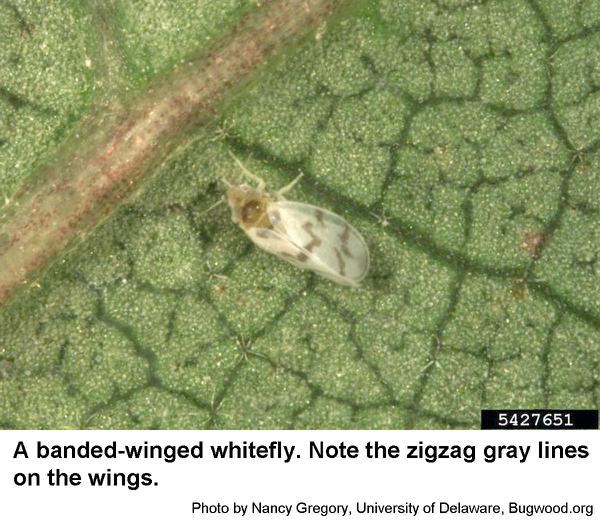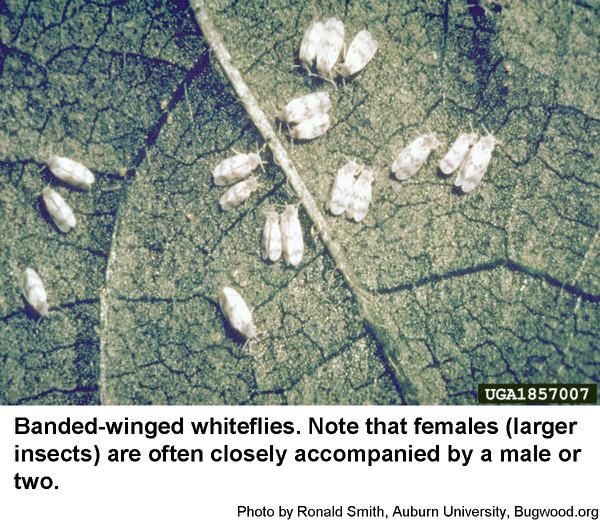Description and Biology
The bandedwinged whitefly, Trialeurodes abutiloneus, was first described from velvetleaf (Abutilon theophrasti) from which it got its specific epithet. It resembles the closely related greenhouse whitefly, but the wings have two distinct, gray, zigzag lines across them. This native whitefly can overwinter successfully outdoors. Females insert the tips of smooth, oblong eggs into the lower leaf surface. Sometimes the pale yellow to pink eggs are arranged in a circle. From the eggs hatch tiny, yellow crawlers that crawl about until they insert their long, needle-like mouthparts in the lower surface of their host leaf. They feed by sucking out sap, and they excrete honeydew, a clear, sweet, viscous liquid. Nymphs are translucent white with a yellow spot on each side. They grow into almost 1/16 inch long, oval pupae with vertical sides and a fringe of wax filaments along the upper edge. Pupae have a dark area in the upper surface (lacking on the pupae of greenhouse whiteflies). We have several generations per year in North Carolina.
Host Plants
The bandedwinged whitefly is considered to be polyphagous (it feeds on just about any plant). It has been reported from beggarticks, cotton, geranium, hibiscus, mallows, petunia, poinsettia, ragweed, and velvetleaf. Heavily infested plants become unthrifty and yellowish. Honeydew excreted by bandedwinged whitefly nymphs and the sooty molds that grow in it further detract from the appearance of infested plants.
Residential Recommendations
Years ago this was a serious pest of ornamental plants, but when synthetic organochlorine, organophosphate and carbamate insecticides were introduced in the 1940's, the bandedwinged whitefly seemed to drop out of the picture. Now it is an occasional pest moving from weeds into landscapes and greenhouses. Insecticidal soaps and the horticultural oils should give moderately effective control of the bandedwinged whitefly. Other insecticides available in garden centers and big box stores should also give adequate control of bandedwinged whiteflies as long as the pesticides are labeled for whitefly management.
References
- Insect and related Pests of Flowers and Foliage Plants. Baker, J. R., ed. 1994. North Carolina Cooperative Extension Service Pub. AG-136. 106 pp.
- The bandedwinged whitefly, Trialeurodes abutilonea, in Florida (Homoptera: Aleyrodidae: Aleyrodinae). Hamon, A. B. 1991. Florida Dep. Agr. & Consumer Serv. Div. Plant Ind. Entomology Cir. 340. 2 pp.
- Whiteflies. Anonymous. 2002. Texas A&M AgriLife Extension. B-6127.
- Whiteflies. Flint, M. L. 2015 (revised). How to Manage Pests, Pests in Gardens and Landscapes, UC IPM, University of California Agriculture & Natural Resources.
- Extension Plant Pathology Publications and Factsheets
- Horticultural Science Publications
- North Carolina Agricultural Chemicals Manual
For assistance with a specific problem, contact your local Cooperative Extension Center
This Factsheet has not been peer reviewed.
Publication date: Aug. 31, 2017
Reviewed/Revised: June 10, 2022
Recommendations for the use of agricultural chemicals are included in this publication as a convenience to the reader. The use of brand names and any mention or listing of commercial products or services in this publication does not imply endorsement by NC State University or N.C. A&T State University nor discrimination against similar products or services not mentioned. Individuals who use agricultural chemicals are responsible for ensuring that the intended use complies with current regulations and conforms to the product label. Be sure to obtain current information about usage regulations and examine a current product label before applying any chemical. For assistance, contact your local N.C. Cooperative Extension county center.
N.C. Cooperative Extension prohibits discrimination and harassment regardless of age, color, disability, family and marital status, gender identity, national origin, political beliefs, race, religion, sex (including pregnancy), sexual orientation and veteran status.




